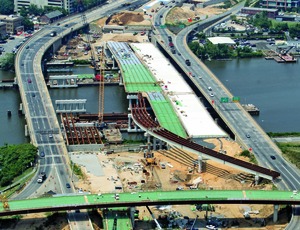
While Interstate 695 and I-295 are on either side of the Anacostia River, the two have never met. As a result, more than 100,000 daily vehicles must squeeze over the river across the pair of 11th Street bridges into the streets of District of Columbia neighborhoods.
But a reconstruction project, including three new bridges and a complex new network of connecting ramps, is now under way to change that. With limited funds, the District Dept. of Transportation took a "design-build to budget" approach.
Prequalified teams met with DDOT in 2009. "The owner said, 'For $260 million, what can you build?' " recalls Bjarne Gudmundsen, project control manager for a joint venture of Skanska USA and Facchina Construction Co. Inc.
Each of the five teams met with a panel and made a presentation to answer that question. Skanska-Facchina's plan fulfilled the most functions desired as an outcome of the job, with the least public impact. Inbound and outbound regional traffic will be served by two steel-girder bridges, each with four lanes in one direction and built between the existing two old bridges. Inbound and outbound local traffic will be carried by a single bridge with four lanes, two in each direction.
The project links to a larger 37-mile corridor plan to revitalize the Anacostia River communities, says Ronaldo T. "Nick" Nicholson, DDOT's chief engineer. A veteran on the $2.5-billion Woodrow Wilson Bridge project, he says this project is similar in that it replaces structures that have reached the end of their service lives and involves the linking of two dense urban riverside communities.
The new local bridge will provide a path for pedestrian and bicycle traffic and also accommodate streetcar tracks. The existing bridges will be removed, except for portions of the piers, which will be retained for use as osprey nesting and pedestrian viewing platforms.
On the southeast side of the river, crews are reconstructing an interchange along with the new bridges, each approximately 1,000 ft long and providing a seamless interstate route connection. Realigned sections of I-295 include retaining walls as long as 1,000 ft and a 1,000-ft-long flyover ramp. On the northwest side of the river, crews are building a new three-lane connection to I-695.
"We will take up to 65% of traffic off the south side's neighborhood streets," says Gudmundsen. The team, which includes a design joint venture of JMT and AECOM, submitted a 30% design document to DDOT, which then conducted a final environmental impact study.
The job requires a total of 300,000 cu yd of earthmoving. In addition to appeasing communities, the U.S. Park Service and the U.S. Navy, workers worked around old rail tracks, existing traffic and a slew of "extremely old" utilities in the river, adds Brook Brookshire, the project's executive. Some of the utilities required decommissioning, and others required relocation. A sonar of the river discovered old boats, cars and appliances. "You can't drive piles through those," he says.
The 63 piles for the three new bridges are hollow, concrete cylinders, averaging 110 ft in length and driven about 70 ft into the riverbed. Unstable earth conditions called for a multitude of ground improvement methods, including lightweight aggregate, geofoam blocks, wick drains and ground concrete columns, notes Brookshire. In compensation for demolishing an old boathouse, the team built a new one upriver for the local rowing team.


Post a comment to this article
Report Abusive Comment